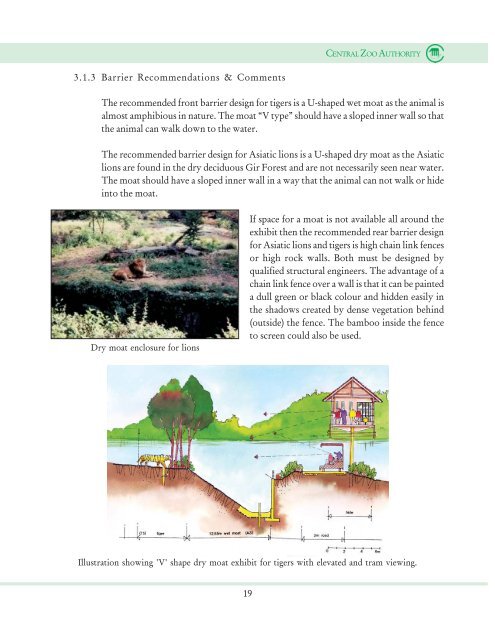Barrier Designs for Zoos - ZooLex Zoo Design Organization
Barrier Designs for Zoos - ZooLex Zoo Design Organization
Barrier Designs for Zoos - ZooLex Zoo Design Organization
Create successful ePaper yourself
Turn your PDF publications into a flip-book with our unique Google optimized e-Paper software.
3.1.3 <strong>Barrier</strong> Recommendations & Comments<br />
19<br />
CENTRAL ZOO AUTHORITY<br />
The recommended front barrier design <strong>for</strong> tigers is a U-shaped wet moat as the animal is<br />
almost amphibious in nature. The moat “V type” should have a sloped inner wall so that<br />
the animal can walk down to the water.<br />
The recommended barrier design <strong>for</strong> Asiatic lions is a U-shaped dry moat as the Asiatic<br />
lions are found in the dry deciduous Gir Forest and are not necessarily seen near water.<br />
The moat should have a sloped inner wall in a way that the animal can not walk or hide<br />
into the moat.<br />
Dry moat enclosure <strong>for</strong> lions<br />
If space <strong>for</strong> a moat is not available all around the<br />
exhibit then the recommended rear barrier design<br />
<strong>for</strong> Asiatic lions and tigers is high chain link fences<br />
or high rock walls. Both must be designed by<br />
qualified structural engineers. The advantage of a<br />
chain link fence over a wall is that it can be painted<br />
a dull green or black colour and hidden easily in<br />
the shadows created by dense vegetation behind<br />
(outside) the fence. The bamboo inside the fence<br />
to screen could also be used.<br />
Illustration showing 'V' shape dry moat exhibit <strong>for</strong> tigers with elevated and tram viewing.
















